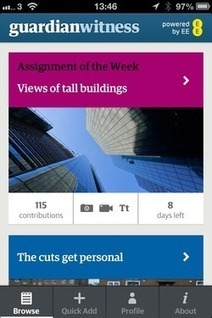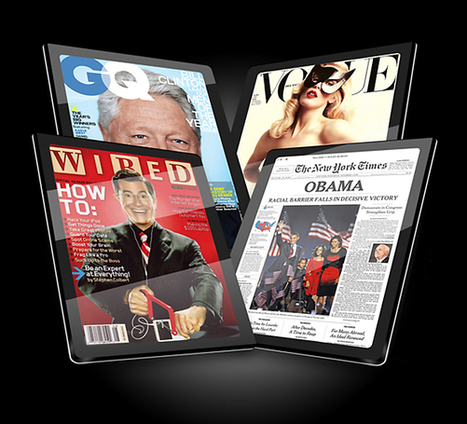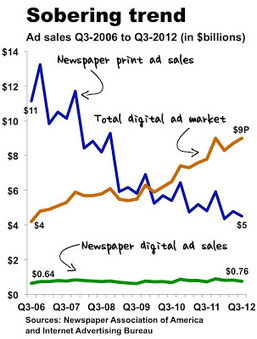 Your new post is loading...
 Your new post is loading...
BuzzFeed gets free content, users get exposure, we get 11 Engagement Photos That Will Make You Happy You’re Single. ... The department devoted to creating this “old school” content is known as BuzzTeam. Their focus is anything shareable — lists, animals, nostalgia. The kind of content that BuzzFeed’s loyal readers have become hyper-familiar with. Many, in fact, have consumed so many such BuzzFeed posts that they’ve become adept at mimicking both their tone and their viral success. Earlier this month, BuzzFeed’s editors took a step toward giving those faithful followers a little more of the spotlight they crave. Shepherd, along with a staff of four, now run BuzzFeed Community, a content-producing vertical of its very own, complete with featured posts by community members and a leaderboard with the latest on who’s posts are getting the most traffic, likes, comments, and badges. It’s a competitive place, and anyone can join and enter the fray....
Guardian digital development editor Joanna Geary answers some questions about GuardianWitness.... ...First up: this was built in two months. The sponsorship pot from EE gave them a budget and time to get the job done, but not necessarily have everything they wanted at launch. She says it's a complete, working system that can be built upon. I suggest the phrase "minimum viable product" to Jo but she suggests that it's a full product - one that will be built on. Do they have aspirations for more integration with social media? Yes, they do. And it's something they're looking at as the system develops. The key part of the development which is invisible to us right now is that the Guardian Witness system is deeply integrated with the Guardian's CMS. Once the content has passed through verification, it's available to the journalists, and they can insert it into a story or liveblog just by inserting an URL, which creates an embedded version of the contribution that links back to the contributor's profile. "The really exciting thing is not what you see now, but what you see when Witness is included in a story," she says. It's a tool to facilitate genuine collaborative working between the journalist and external witnesses. Jo says they'll collaborate with people on the ground, or with expert knowledge, in any way they can - and already do, via phone and other traditional methods. This adds another tool for doing that....
In the wake of the Boston Marathon, I have but one ask for the media: please tell us NO.... ... While Twitter might offer up a 6-second video of one of yesterday’s horrific explosions, it’s your profession that is charged with relaying that information. In the race for clicks, pageviews, and traffic, I’ve seen the most trusted news sources with banner three-letter monikers devolve into sensationalized sites catering to this now now now generation’s demand for anything. “Anything — just give us anything,” we cry. But it would be lovely if you told us “no.” No – we will not capitalize on over-graphic images that would get a Hollywood blockbuster an R-rating. No – we will not use cultural or nationality indicators when reporting that there is a suspect in custody. Why? Because we know the most important words in those statements are “in” and “custody” as opposed to where one was born or the depth of one’s suntan....
In a reverse to the long established journalistic tenet that “if it bleeds it leads” it appears that when it comes to social media we’d rather smile and share. It is as if the “and finally” fluffy story at the end of television news is the one that dictates our sharing habits when it comes to social networks and other forms of online communication. This probably explains how cats have come to dominate the web. This is according to a New York Times report that says neuro-scientists and psychologists have found that good news spreads faster and goes further than disasters and bad news stories. Jonah Berger, a social psychologist at the University of Pennsylvania says the difference lies in the fact that when we share stories with friends we like to share good news....
Des Moines-based Meredith, best known for Better Homes and Gardens, has discovered the secret to keeping magazines profitable... Meredith has profited from a few key strategies. They are experts at repurposing their content across multiple platforms (magazines, books, websites, mobile devices, tablets, etc.) and aggressively look beyond advertising and circulation for revenue. In print, they stay as far away from the news as possible. They are particularly successful at licensing their magazine titles’ names to major national businesses selling branded products; they also run their own marketing agency. Meredith hasn’t been immune to the forces battering the industry. But over the past decade, by strategically tweaking their portfolio, they’ve managed to maintain steady profits and reliable margins year after year in spite of the turbulence. (Lacy declined to comment.) In February, Meredith published one of its signature editorial products—a “bookazine” called Chicken Dinners. It was flush with ads, co-branded under the Better Homes and Gardens imprimatur, and sold with no expiration date. In theory, it could live on a newsstand—or a coffee table or a kitchen counter—for many months. “Chicken Dinners is Chicken Dinners whether you buy it in May, June, or July,” says Samir Husni, the director of the Magazine Innovation Center at the University of Mississippi. Some 88 years after Harold Ross launched The New Yorker with the pitch that it was “not edited for the old lady in Dubuque,” Iowa is turning into a surprising seat of power....
...Just like last year, researchers also found that Fox News is both the least trusted and most trusted network when compared to the other networks in the survey. Thirty-four percent said they trust Fox News the most, while 39 percent said they trust it the least. Other news outlets are not entirely better off. Thirty-five percent of respondents said they trust MSNBC, while 44 percent said they do not. When it comes to CNN, 38 percent of voters said they trust the network, but 43 percent said they trust the cable network the least. PBS is the only outlet that respondents trust more than distrust, with 52 percent of voters saying they trust the network, and 29 percent saying they do not....
...Ad-supported journalism is being consumed in record quantities, but those of us who manage media companies face a stark reality: Traditional advertising dollars in print and broadcast become dimes on the full-scale web, and they tend to disappear entirely on mobile devices. Alternative revenue models, then, are key to success, but only if they follow ethics guidelines that protect media outlets from losing credibility with readers. Sponsored content, as it is now being published on the full-scale and mobile web, differs from old-fashioned print advertorial in significant ways. The biggest departure is that, rather than passively receiving and publishing advertorial copy from ad agencies, media outlets are more often partnering with brands to create custom-content “native advertising” campaigns that resonate with readers who fit the publication’s demographic profile. BuzzFeed, for instance, employs a large staff to craft brand-marketing pieces that readers will share with friends via Facebook and other social networks. One such recent post, “11 Things No One Wants To See You Instagram,” quickly drew 330,000 views on behalf of advertiser Virgin Mobile, the Wall Street Journal reported. Similarly, Forbes Media created a Forbes BrandVoice program through which brands can submit paid articles to the Forbes website. “The advertiser-sponsored copy appears in the same style and format as articles contributed by Forbes writers and editors,” New York Post media columnist Keith J. Kelly reported in November. (The BrandVoice connection is noted at the top of posts.) This is a Wild West moment for sponsored content...
Welcome to the new Mashable. After two weeks of beta testing, we're excited to launch an all-new version of the site that delivers a better experience on every device -- from phones to tablets to desktops and beyond.... [Mashable's launch tag line sends a message to media, PR and every organization: Social, Mobile, Visual ~ Jeff]
The behavior of television viewers is changing, but the industry is not changing with them fast enough or in the right ways. That was the consensus of panelists at the HRTS newsmaker luncheon Wednesday in Century City. “A lot of us -- the way we conduct ourselves -- we have our head up our ass,” said Kevin Reilly, chairman of entertainment at Fox Broadcasting Co., during the panel, which was titled "The State of Broadcast." Reilly said the industry has not gotten its arms around the impact of the DVR or the need to consider how viewers embrace and engage with a show, as well as how it rates. He added that a lot of people who make TV don’t actually watch it the way real people watch it. Habits are changing in the age of the DVR, Netflix and Hulu, he said.... [Reilly serves a wake-up call on the TV industry ~ Jeff]
But newspapers rank low in usage for 12-18 year olds... The rather unsurprising, if somewhat depressing, result of a new survey shows that not too many British teenagers are reading newspapers. More surprisingly, their preferred news provider is radio rather than online. According to a survey conducted by the youth writing website Movellas.com, 61% (of the 30,000 12-18 year olds it polled*) said radio was the best way to keep up with the news. Given a multiple choice list of preferences, second place went to television news at 58% with the social networks Twitter and Facebook following at 56% and 52% respectively. Printed paid-for newspapers came in at 26% while free daily papers managed just 22%.... [Interesting to note the news preferences of each demographic.~ Jeff]
|
Traditional news organizations need to embrace the disruption brought by digital culture -- or they risk becoming obsolete. That was the message late last week at the International Symposium on Online Journalism hosted by the Knight Center for Journalism in the Americas at the University of Texas at Austin, where about 370 of the world's journalists, researchers and media watchers grappled with the hard questions for a beleaguered traditional media industry that is now more than a decade into its disruptive transformation. The problem is many media companies view digital technologies through a lens of traditional journalism and thus, fail to strategize properly, said Clark Gilbert, president and CEO of Deseret News Publishing Company. "In a post-disruption world, why would people pick up a paper at all? Why would someone turn on the 10 o'clock newscast?" Gilbert asked. "If you are not asking those fundamental questions, there is not a future for you legacy organization." The key to surviving? Innovate. Fail. Innovate again....
Natural disasters, airline crashes — and yes, terrorist bombs — undercut the normalcy of everyday life by bringing death’s whammy to an unexpected place at an unforeseen time. In the hours and days following such catastrophes, journalists work to restore normalcy to the panicked population by explaining how and why the bad thing happened and how to prevent it from happening again. Reporters have been normalizing the abnormal for so long that they’ve created well-worn catastrophe templates to convey their stories. Yesterday, while covering the Boston Marathon bombing, journalists leaned hard again on those templates. First came the sputtering dispatches over radio and television about the calamity. Next up were the on-the-scene broadcast reports, frequently marred by confusion and contradiction, as the press held out hope for survivors but prepared audiences for the worst. Video of the catastrophe was converted by the cable news networks into a perpetual loop, giving the talking heads a wallpaper background to talk over (and giving new viewers just tuning in something graphic to watch)....
Terrible events such as yesterday’s bombings at the Boston Marathon have always meant “all hands on deck” for news organizations, with staffers pulled off their regular beats to contribute. But the endpoint of the newsgathering and reporting is no longer a front-page package of stories explaining — the best one can — what happened, why it happened and what might be next. Now, there is no endpoint — events are reported in real time, with stories in constant motion, and the front page is a snapshot of an organization’s reporting at the moment when the presses needed to roll. Boston was a reminder of that, and a look at what’s changing in real-time journalism. Through Twitter and various live blogs, I found myself looking over my shoulder at the Boston Globe, the New York Times, Reuters and other news organizations, and was able to make some observations and draw some conclusions....
The ticking time bomb that has defined the intersection of print and digital publishing went off over the past few weeks. It’s not the fault of any executive, technology or business model. It’s simply the beginning of a new cycle of magazine content and delivery. It you love magazines, it’s all about discovery and great value right now. If you don’t like magazines, this explosion increases the chances that you just might change your mind. Think about this: We’re coming off a week in which one of the world’s biggest publishing companies (Time Inc.) tried to sell its library to another of the world’s biggest publishing companies (Meredith). The deal fell apart. And in the same week, another global giant (News Corp) announced that its newly spun-off publishing division will get a $2.5 billion cash infusion, some of which will spawn a new WSJ.Money print magazine, and some of which will go to digital newspaper publishing. This mass change, growth, and implosion is the reality for publishers over the next few years. It’s print vs. digital, and a game of survival of the fittest. Behind the scenes, some publishing executives are clinging to the vision that print will still be the best business magazine model for the right content and the right audience. And then others are seeing the dramatic changes with the long-term view that digital models will win out. This is happening faster than most people think....
On Wednesday, during an interview with HuffPo Live, former White House Communications Director Anita Dunn said that the departure of Dick Morris and Sarah Palin from Fox News signals that the network’s “alternative universe” is crumbling. Dunn created a controversy in 2009 when she told Time magazine that Fox News is “opinion journalism masquerading as news,” and followed that up on CNN by saying that the network “often operates as the research arm of the Republican Party.”...
The news cognoscenti gasped when the Columbia Journalism Review recently reported that the nation’s leading newspapers aren’t writing as many long stories as they used to. But I think most stories are still way too windy. In a moment, I’ll tell you why, as briefly as I can. First the background: Tallying yarns topping 2,000 words on Factiva, CJR found the number of long-form stories at the Los Angeles Times dropped by 86% between 2003 and 2012. In the same period, stories of similar heft fell by 50% at the Washington Post, 35% at the Wall Street Journal and 25% at the New York Times. “When it comes to stories longer than 3,000 words, three papers showed even sharper declines,” said CJR. The number of super-sized stories dropped everywhere but the NYT, which actually had a 32% increase in articles of 3,000 words or more. Remember the epic Snowfall?...
Newspaper print ad sales have declined more than $20 billion in six years. In that time, digital ads growth has erased only 2% of the losses. Emma Gardner of the Economist Group presents a visual look back at digital publishing in 2012. No visual struck me more than the graph below showing the extent of devastation to newspaper print ad sales since 2006: $20 billion in annual revenue, down the drain. In that time, digital ad growth has erased only 2% of the losses. How dreadful.
Where did the digital money go? It went to new online marketplaces, and apps, and sites. And Google. Yeah, basically the money went to Google. In 2006, Google made $60 billion less than U.S. newspapers and magazines. Now it makes more ad money than all of U.S. print media combined. Wow....
Laura Lang hires Meredith video exec to lead new group... More changes are afoot at Time Inc. following the reshuffling CEO Laura Lang kicked off last summer. Today, in a company-wide memo, Lang announced the launch of a new digital video unit, a recognition that the company's brands need to tap new, potentially lucrative sources of revenue as their traditional print business continues to decline.... [Traditional media are finally recognizing the need for video. The bigger question is whether marketing and PR are shifting to video fast enough to meet the market place?]
A new study finds that the use of computers and Facebook are more associated with information overload than the use of television and iPhones. ...What the findings suggest, Holton said, is that the news platforms a person is using can play a bigger role in making them feel overwhelmed than the sheer number of news sources being consumed. So even if you read The Huffington Post, BuzzFeed, The New York Times, and ESPN in a day, you may not feel as inundated with news if you read on your phone instead of on your desktop (with 40 tabs open, no doubt). The more contained, or even constrained, a platform feels, the more it can contribute to people feeling less overwhelmed, Holton said. A news app or mobile site, for instance, is an isolated experience that emphasizes reading with minimal links or other distractions. Compared with reading on the web at your computer, your options seem smaller.... [This is a fascinating news consumption study ~ Jeff]
What's the best cable news network on television? According to a recent telephone survey conducted by Poll Position, a company headed by former CNN president and news chief Eason Jordan, it's Fox News.
|



 Your new post is loading...
Your new post is loading...
























Here's a look at how BuzzFeed creates buzz and wIll get even more with its new BuzzFeed community initiative. Nice insight for media and bloggers. Buzz buzz buzz buzz buzz buzz buzz.